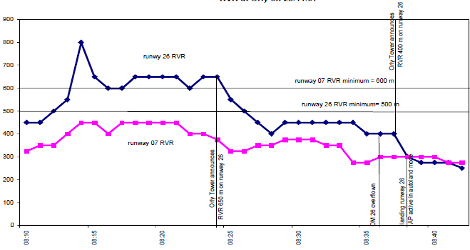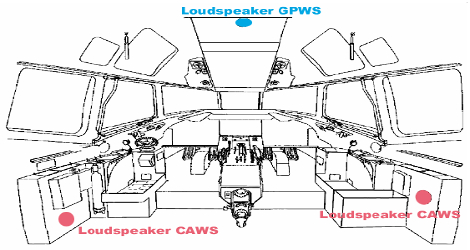The evolution of the Aom Minerve flight IW68 was analyzed on the basis of flight documents, recorded data and witness statements.
On Sunday 23 November 1997, the crew flew the Toulon-Orly-Marseille route stages : on the previous day, they had flown the Orly-Nice-Orly-Toulon route stages.
The crew of Aom Minerve flight IW68 consisted of a Captain instructor and two first officers (FO) on Line Oriented Flight Training (LOFT). The two FO’s on LOFT occupied the copilot’s and observer seats alternately.
The airplane, an MD83 registered F-GRMC, landed at Marseille at 10 h 35. During the preparation of the Marseille-Orly flight, the crew received a meteorological file. The alternate airport was Paris-Charles de Gaulle.
The flight dossier indicated that Aom Minerve flight IW68 was carrying 20,000 pounds of fuel. The Captain stated that he had loaded sufficient fuel in reserve to return to the South of France in case the meteorological conditions made a landing at Orly impossible.
At 11 h 25, the airplane took off from Marseille with 131 passengers and 7 crewmembers. The co-pilot was pilot flying.
The flight took place without any notable events until the preparation of the approach to Orly.
The autothrottle and autopilot 2 were connected throughout the flight. The crew prepared category I, II and III precision approaches on runways 07 and 26 at Orly.
At 11 h 53, Paris ATC announced RVR of 400 meters on runway 07.
At 12 h 07 the Captain of Aom Minerve flight IW68 took over as pilot flying.
At 12 h 14 min 43 s, the crew contacted Orly Approach which announced RVR of 500 meters.
At 12 h 26 min 23 s, the Captain selected track 258° on the VHF NAV 1 (left) instead of 065°, the correct approach track.
The co-pilot did not check the display.
At 12 h 28 min 33 s, the Captain armed the “autoland” mode.
At 12 h 29 min 34 s, Orly Approach ended radar vectoring and transferred the airplane to the Tower controller at an altitude de 3,000 feet, at a speed of 160 kt, on heading 020° for interception of the runway 07 ILS. The co-pilot had selected track 065° on the OL VOR. He announced that the airplane was crossing this track.
At 12 h 29 min 43 s, the “LOC capture” mode appeared on the Flight Mode Annunciator (FMA). The Captain announced “LOC capture heading QFU” and, looking at the HSI, he brought the heading indicator to the tail of the ILS bar. He later stated that he thought at that time that he had brought the heading indicator to the head of the arrow and not to the tail.
He then noticed that the heading indicated 078° while he expected the QFU of runway 07, that is to say 065°. At 12 h 29 min 53 s, Orly Tower announced RVR of 400 metres.

Aom Minerve flight IW68
Subsequently the Captain did not announce the actions he took relative to the automatic systems.
At 12 h 29 min 59 s, the Captain selected a 060° heading on the DFGS. At 12 h 30 min 01 s, he armed the “ILS” mode. At 12 h 30 min 03 s, the “LOC CAPTURE” mode appeared again on the FMA. At 12 h 30 min 07 s, the Captain selected the same heading of 060 on the “HEADING” mode.
The heading increased progressively. The Captain requested that the landing gear be extended. At 12 h 30 min 20 s, the airplane went above the approach track. At 12 h 30 min 29 s, the Captain armed the “ILS” mode.
A 12 h 30 min 40 s, he armed the “autoland” mode, displayed an altitude of 2,000 feet, selected a descent speed of around 2,300 feet per minute and a heading of 090°.
The airplane came back towards the approach track and descended in clear skies.
The Captain then realized that he had selected an ILS heading of 258° instead of 065° and corrected it.
A short time afterwards, Orly Tower indicated that the airplane was 1.5 NM north of the track. The flaps were extended to 40° and the Captain selected the final approach speed. During this time, the airplane went below the glideslope track. Then, with the Captain’s authorization, the co-pilot selected the ILS on the right side, instead of the OL VOR.
From 12 h 31 min 26 s, at a radio height of 916 feet, the Ground Proximity Warning System (GPWS) “Glideslope” warning was recorded by the QAR. The airplane entered the fog at that moment or a few seconds later.
During the descent, the pilot of Aom Minerve flight IW68 saw that the bar of the glideslope track was up against its stop and said “glide” twice.
At 12 h 31 min 28 s, the Captain disconnected the autopilot. At a radio-height of 783 feet, the “Terrain” warning was recorded for two seconds by the QAR. The “Glideslope” warning started up again as soon as the “Terrain” warning ended.
The Captain tried to bring the airplane back onto the approach track. At 12 h 31 min 43 s, the “LOC capture” mode appeared on the FMA again. At 12 h 31 min 49 s, the Captain re-connected the autopilot, at a radio-height of 415 feet. He then armed the “autoland” mode.
At a radio-height of 279 feet, the “terrain” warning was recorded again for a further nine seconds. At 12 h 31 min 56 s, the Captain disconnected the autopilot and began a go-around.
At that moment, the radio-height was about 200 feet. At 12 h 32 min 09 s, the minimum radio-height of 67 feet and the Outer Marker signal were recorded. The co-pilot would state that he saw the ground and read a radio-height of about 50 feet The go around and the runway circuit were performed with radar vectoring.
The landing took place in “autoland” mode. The airplane landed at Orly at 12 h 45.
The incident of Aom Minerve flight IW68 resulted from the decision to put the airplane into descent when, as a result of a display error, it was neither on the localizer track nor on the glide path, and with no context defined for this improvised maneuver.
The importance that Aom Minerve flight IW68 attached to accelerated training given to new co-pilots and to undertaking commercial flights contributed directly to the incident.
Other contributory factors were:
- the pilot’s fatigue;
- the imbalance in the flight crew, made up of a very experienced instructor and an under-trained co-pilot, which led to the abrupt disappearance of teamwork and procedures the moment the workload increased;
- airplane warning system ergonomics and a fault in the automatic pilot system
Download Report


0 Comments